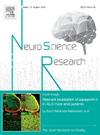TDP-43 功能丧失与肌萎缩侧索硬化症/颞前痴呆症相关基因的分子机制。
IF 2.3
4区 医学
Q3 NEUROSCIENCES
引用次数: 0
摘要
肌萎缩侧索硬化症(ALS)和额颞叶痴呆症(FTD)的特征是 TAR DNA 结合蛋白-43(TDP-43)的核耗竭和胞质聚集。TDP-43 在调节包括 TARDBP 在内的许多基因的剪接过程中发挥着关键作用。本综述旨在阐述 ALS/FTD 发病机制中与 TDP-43 功能相关的两个方面。首先,我们对 TDP-43 的靶基因 UNC13A 的剪接提供了新的机理认识。UNC13A 中的单核苷酸多态性(SNPs)是 ALS/FTD 最常见的风险因素。我们发现,在 UNC13A RNA 剪接过程中,TDP-43 会抑制 "隐性外显子 "的包含。该外显子中的风险相关 SNP 会导致保留隐性外显子的 UNC13A RNA 水平升高。其次,我们描述了与年龄相关的 DNA 去甲基化对 TDP-43 自动调节机制的干扰。衰老是散发性 ALS/FTD 的主要风险因素。通常,TDP-43的水平通过TARDBP mRNA的替代剪接来调节。我们假设 TARDBP 甲基化会因衰老而改变,从而破坏 TDP-43 的自动调节。我们发现,去甲基化会降低替代剪接的效率,增加 TARDBP mRNA 的水平。此外,我们还证明,随着年龄的增长,人类运动皮层中的这一区域会发生去甲基化,并与 ALS 的早期发病有关。本文章由计算机程序翻译,如有差异,请以英文原文为准。
Molecular mechanisms linking loss of TDP-43 function to amyotrophic lateral sclerosis/frontotemporal dementia-related genes
Amyotrophic lateral sclerosis (ALS) and frontotemporal dementia (FTD) are characterized by nuclear depletion and cytoplasmic aggregation of TAR DNA-binding protein-43 (TDP-43). TDP-43 plays a key role in regulating the splicing of numerous genes, including TARDBP. This review aims to delineate two aspects of ALS/FTD pathogenesis associated with TDP-43 function. First, we described novel mechanistic insights into the splicing of UNC13A, a TDP-43 target gene. Single nucleotide polymorphisms (SNPs) in UNC13A are the most common risk factors for ALS/FTD. We found that TDP-43 represses “cryptic exon” inclusion during UNC13A RNA splicing. A risk-associated SNP in this exon results in increased RNA levels of UNC13A retaining the cryptic exon. Second, we described the perturbation of the TDP-43 autoregulatory mechanism caused by age-related DNA demethylation. Aging is a major risk factor for sporadic ALS/FTD. Typically, TDP-43 levels are regulated via alternative splicing of TARDBP mRNA. This review focused on that TARDBP methylation is altered by aging, thereby disrupting TDP-43 autoregulation. It was found that demethylation reduces the efficiency of alternative splicing and increases TARDBP mRNA levels. Moreover, we demonstrated that, with aging, this region is demethylated in the human motor cortex and is associated with the early onset of ALS.
求助全文
通过发布文献求助,成功后即可免费获取论文全文。
去求助
来源期刊

Neuroscience Research
医学-神经科学
CiteScore
5.60
自引率
3.40%
发文量
136
审稿时长
28 days
期刊介绍:
The international journal publishing original full-length research articles, short communications, technical notes, and reviews on all aspects of neuroscience
Neuroscience Research is an international journal for high quality articles in all branches of neuroscience, from the molecular to the behavioral levels. The journal is published in collaboration with the Japan Neuroscience Society and is open to all contributors in the world.
 求助内容:
求助内容: 应助结果提醒方式:
应助结果提醒方式:


